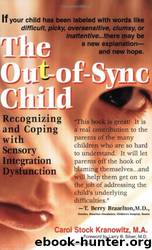The Out-of-Sync Child by Carol Stock Kranowitz

Author:Carol Stock Kranowitz [Kranowitz, Carol Stock]
Language: eng
Format: epub
Publisher: Penguin USA, Inc.
Published: 0101-01-01T00:00:00+00:00
Two Components: Defensive (“Okay!” or “Uh, Oh!”) and Discriminative (“Aha!”)
The auditory sense, like the other senses, begins with a defensive component. As babies, we startle when we hear loud or unexpected noise. Gradually, our brains develop the ability to modulate sensations and tell us whether the sound is one we can enjoy and use or must avoid for self-protection. When we realize that a sound was just a door shutting, and not a danger, we return to a state of being calm and alert.
The abilities to hear and to modulate sensations of sound underlie our ability to really listen to sounds around us and understand their meaning. We are not born with the skill of listening; we acquire it, as we integrate vestibular and auditory sensations. Gradually, as we interact purposefully with our environment, we learn to interpret what we hear and to develop sophisticated auditory discrimination skills.
The discriminative component of the auditory sense evolves as the child moves, touches, and engages in many multisensory experiences. Discriminative functions, which help us refine details about the “what” and “where” of sounds, include:
• Localization—the ability to identify the source of a sound, such as a parent’s voice, or a friend’s “Yoo-hoo!”—and to judge the distance between the sound and oneself.
• Tracking—the ability to follow a sound, such as a helicopter as it putters across the sky or someone’s footsteps as he patters around the house.
• Auditory memory—the ability to remember what was heard, e.g., conversations, directions, homework assignments, or song lyrics, and to refer to it at once (immediate memory) or later (deferred memory).
• Auditory sequencing—the ability to put in order what was heard and repeat it in logical order, such as the alphabet, Spanish verb conjugations, or multisyllabic words like “obstacle” or “nuclear.”
• Auditory discrimination—the ability to compare and contrast environmental sounds, such as a food blender and a vacuum cleaner, and to hear likenesses and differences in word sounds, such as road/load, flute/fruit, cup/cut.
• Auditory figure-ground—the ability to distinguish between foreground and background sounds, in order to hear the main message without being distracted.
• Association—the ability to relate a novel sound to a familiar sound, such as connecting the bark of the neighbor’s new puppy to the category of “dog,” and the ability to relate a visual symbol, such as an alphabet letter or a musical note, with its particular sound.
• Auditory cohesion—the higher level listening ability to unite various ideas into a coherent whole, to draw inferences from what is said, to understand riddles, jokes, puns, and verbal math problems, and to take notes in class.
• Auditory attention—the ability to maintain focus sufficiently to listen to a teacher’s lesson, a conversation, or a story, essential for bringing the other auditory processing skills together.
Download
This site does not store any files on its server. We only index and link to content provided by other sites. Please contact the content providers to delete copyright contents if any and email us, we'll remove relevant links or contents immediately.
The Lost Art of Listening by Michael P. Nichols(6465)
Rich Dad Poor Dad by Robert T. Kiyosaki(5140)
We Need to Talk by Celeste Headlee(4863)
I Love You But I Don't Trust You by Mira Kirshenbaum(3224)
The Complete Idiot's Guide to Coping With Difficult People by Arlene Uhl(2821)
Rich Dad Poor Dad: What The Rich Teach Their Kids About Money - That The Poor And Middle Class Do Not! by Robert T. Kiyosaki(2432)
Life Hacks by Dan Marshall(2154)
Dealing with People You Can't Stand by Dr. Rick Brinkman(2058)
A Burst of Light by Audre Lorde(1979)
An Odyssey by Daniel Mendelsohn(1918)
The Expectant Father by Armin A. Brott & Jennifer Ash(1893)
The Book You Wish Your Parents Had Read (and Your Children Will Be Glad That You Did) by Philippa Perry(1868)
Teach Your Child How to Think by Edward De Bono(1864)
The Out-of-Sync Child by Carol Stock Kranowitz(1774)
No Time to Say Goodbye(1755)
What I Need by J. Daniels(1718)
I Don't Belong to You by Keke Palmer(1663)
The Self-Driven Child by William Stixrud PhD & Ned Johnson(1659)
The 7 Habits Of Highly Effective Teens by Covey Sean(1627)
